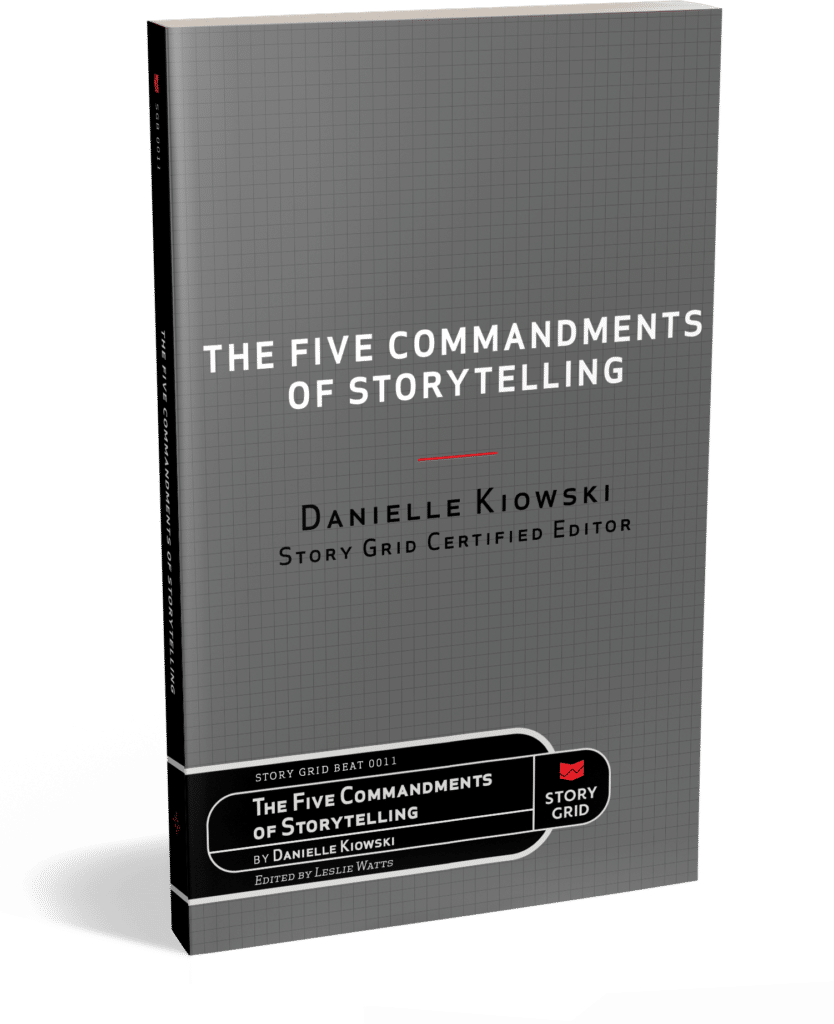The Five Commandments of Storytelling
Written by Danielle KiowskiEdited by Leslie Watts
Will ship by Tuesday, October 19th.
Your story is important. It’s your opportunity to captivate readers and deliver a message that will change their lives forever. But somehow, it’s just not working. You’ve written multiple drafts and tried lots of “tips and tricks.” But time and again, readers aren’t connecting with your characters and the ideas you want to share.
You want readers to care deeply about your story. You want to capture their hearts and change their minds.
Whether you’re writing a mystery, romance, epic fantasy, or coming-of-age memoir, Story Grid Certified Editor Danielle Kiowski has what you need: a proven approach to construct a story arc that connects readers with your characters to deliver the message at the heart of your story. This approach is called The Five Commandments of Storytelling.
And just what are the Five Commandments?
- Inciting Incident
- Turning Point Progressive Complication
- Crisis
- Climax
- Resolution
Each commandment works with the others to create an arc that reveals character and elicits empathy. Through that connection, readers will find themselves transformed by the power of your story long after they’ve turned the final page.
Kiowski doesn’t simply define the Five Commandments, she shows you precisely how they work in classic novels—including Pride and Prejudice, The Wonderful Wizard of Oz, and The Silence of the Lambs—and in the beloved film, It’s a Wonderful Life.
“To tell your story well, you need to know what makes a story work,” says Kiowski. The Five Commandments of Storytelling is your guide to what makes a great story work.
Isn’t it time to take your story to the next level and change some lives?

Purchasing Options
ALSO AVAILABLE
1: WHY WE TELL STORIES
We create stories to communicate with an audience. As artists, we have something to say, and our stories are the way we pass that message on to audiences that we’ll never meet, across space and time.
When we set out to communicate a message that matters, we have many choices for getting it across to our intended audience. Messages surround us every day. Consider the example of the message that we should be thankful for what we have. We see this repeated all the time in news articles, radio segments, and posted signs—like the signs at restaurants saying, “We don’t have wi-fi. Talk to each other.” We could read academic papers detailing studies that show the power of gratitude. People in our lives might repeat adages, telling us to stop and smell the roses. If we’re acting in a harmful way, well-meaning relatives and friends might tell us directly that we need to change what we’re doing. All of us have heard this message thousands of times. I know I have. Still, every time I see It’s a Wonderful Life, I am glued to the screen as George Bailey discovers this truth for himself, and I cry when he finally reunites with his family and sees the value of the gifts in his life. For many people, watching this story unfold is a yearly tradition. Why does it stick with us?
Narrative is a powerful medium because it bypasses the audience’s resistance and delivers a message they would ordinarily block out. For thousands of years, people have understood the impact a well-crafted story has on the audience.
One of Aesop’s fables, “The North Wind and the Sun,” shows us how this works. One day, the wind and sun had an argument about which was stronger. The two spotted a traveler on the road and agreed that the one that could get him to remove his coat would be the stronger. The wind tried to blow the coat off the traveler’s back, but he only wrapped it tighter and hunkered down against the gale. Then, it was the sun’s turn to try. The sun shone its rays down on the traveler, heating him up. Soon, the traveler removed the coat.
The sun accomplished the desired effect with minimum effort because the traveler thought removing the coat was his own idea.
Persuasion works best when you convince the audience they’ve decided to change on their own. That’s the power of story. Aesop knew that. After all, he told his fables in story form to carry his messages to audiences.
Stories communicate a subtle message to an audience, just as the sun gradually warms the traveler in the fable. Instead of shining, the author creates avatars, which simulate human beings, to act out the story. Without even realizing it, the audience starts to care about them. They connect with the protagonist and accompany them on their journey, watching them grow and change throughout the story. Along the way, audience members change, too.
The audience experiences the story and learns the core message on their own. Through the magic of story, the audience connects with avatars that seem completely different from them. However, they learn that underneath different exteriors, the human experience is universal. In this way, stories bind us together to overcome prejudices and change the world.
This is why learning the craft of storytelling is so important. Well-crafted stories can capture audiences and deliver compelling ideas, but poorly told stories drive audiences away. To tell your story well, you need to know what makes a story work.
2: THE FIVE COMMANDMENTS OF STORYTELLING
Every effective story has five critical components that work together to communicate a message in a way that bypasses readers’ critical minds to touch their hearts and change their worldviews. These components are the Five Commandments of Storytelling.
The Five Commandments ensure that your story resonates with your readers to communicate the message you want to convey. The Five Commandments accomplish this because they simulate psychological patterns that people use to solve problems and process change, and they follow patterns found in stories that have stood the test of time. The Five Commandments work.
The message they communicate to the reader is called the controlling idea. This is a statement of the central lesson of the story—the idea the reader will take away from the story and integrate into how they see the world.
The controlling idea is made up of the story’s value shift and the protagonist’s action. Let’s examine how each piece of this statement contributes to the message the story conveys to the reader.
A value shift signals the global genre of the story. Each genre has a core value spectrum that stories within that genre explore. The controlling idea focuses on the value state at the end of the story. A Love story’s controlling idea might begin with Love triumphs… or Hate results… while a Crime story might be Justice prevails… or Tyranny reigns… This shows the reader the impact of using this story as a pattern for behavior.
The other half of the controlling idea describes the protagonist’s action. In this book, you’ll learn to recognize the moment in the story that matters most to the controlling idea and how to evaluate the protagonist’s choice to create a succinct statement of the pivotal action.
The value shift and the protagonist’s action come together to form one sentence that encapsulates the lesson and drives your story —your controlling idea.
The Five Commandments of Storytelling are the signposts that mark the journey you take with the reader as you communicate your controlling idea. They are a form, not a formula. This means they have universal characteristics that make them effective in any story, but your commandments will be unique to the specific world of your story.
In the following sections, I’ll walk you through each of the Five Commandments in detail. You’ll learn:
- How the commandment functions in your story.
- How it contributes to your controlling idea.
- Why it matters to your reader.
- What to consider when constructing the commandment in your own story.
I’ll show you how the Five Commandments function in different units of story. Global stories are made up of quadrants, sequences, scenes, and beats. Each unit must include the Five Commandments, and the commandments within each unit help it to function effectively individually and as part of the whole.
In the individual commandment sections, I’ll focus on the universal characteristics of each commandment, using examples from global stories. However, keep in mind that the same considerations apply when constructing the Five Commandments for smaller units. We’ll go over how to do that once you have a foundational understanding of how to build each commandment.
Finally, I’ll go over how the Five Commandments work together to create a compelling story and convey the message you want to communicate to your reader.

Danielle is a Story Grid Certified Editor from Las Vegas, Nevada. She is a writer, working on a fantasy spy thriller. She’s also a data scientist and a scuba diving instructor. She specializes in helping fantasy authors bring their worlds to life. She particularly enjoys intriguing stories, delving deep into crime, thriller, and mysterious performance works. As a data scientist, she knows her way around a spreadsheet. As a writer, she shares your passion for story and the written word. She’s looking forward to teaming up with you to help you tell your story.

Leslie Watts is a certified Story Grid editor, writer, and podcaster. She’s been writing for as long as she can remember: from her sixth-grade magazine about cats to writing practice while drafting opinions for an appellate court judge.
When the dust settled after her children were born, she launched Writership.com to help writers unearth the treasure in their manuscripts. She believes writers become better storytellers through practice, and that editors owe a duty of care to help writers with specific and supportive guidance to meet reader expectations and express their unique gifts in the world.
